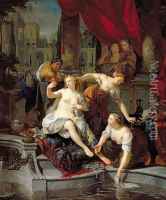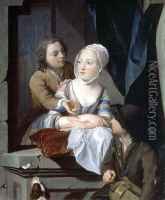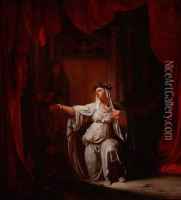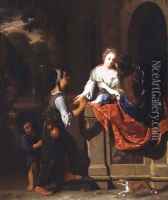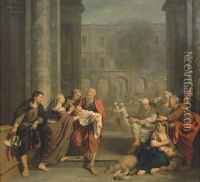Nicolaes Verkolje Paintings
Nicolaes Verkolje was a Dutch painter and mezzotint artist born in Amsterdam in 1673. He was part of the late Dutch Golden Age, a period that is often considered to have been the zenith of Dutch cultural, economic, and artistic development. Verkolje's work is distinguished by its delicate handling of light and shadow, a characteristic feature of the Dutch Golden Age paintings. He was particularly known for his portraits and historical scenes, which were highly regarded for their detailed realism and emotional depth.
Verkolje received his early training from his father, Jan Verkolje, who was also a notable artist of the time. Under his father's guidance, Nicolaes developed a keen eye for detail and a profound understanding of color and composition. His talent was recognized early on, and he quickly established himself as a leading figure in the Dutch art scene. In 1693, at the age of 20, Verkolje moved to Delft, where he spent most of his career. His studio in Delft became a popular destination for art lovers and collectors, and he was soon inducted into the local painters' guild.
Throughout his career, Verkolje embraced the mezzotint technique, which allowed him to achieve remarkable effects of light and shade. This technique became a hallmark of his work and contributed significantly to his fame. His portraits, often of prominent individuals of his time, were celebrated for their lifelike quality and psychological depth. Verkolje's historical and mythological scenes were equally acclaimed, showcasing his ability to weave narrative and emotion into his compositions.
Despite his success, Nicolaes Verkolje's work was somewhat overshadowed by the brilliance of his contemporaries, such as Rembrandt and Vermeer. However, in recent years, there has been a resurgence of interest in his contributions to Dutch art, with scholars and collectors alike appreciating the subtlety and sophistication of his technique.
Nicolaes Verkolje passed away in 1746 in Delft, leaving behind a legacy of artistic innovation and excellence. His works are now held in high esteem and can be found in major museums and collections around the world, testament to his enduring influence on Dutch art.


